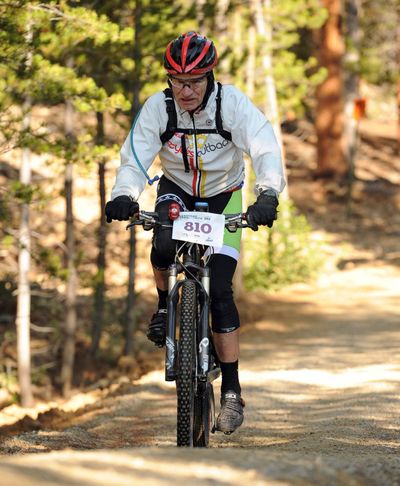No barriers
Don’t let your age stand in the way of physical fitness

When he first got on a mountain bike 20 years ago, Fred Schmid could barely pedal up the 100-foot hill leading to his house. Today the 82-year-old Schmid logs 200-mile training weeks on the dirt roads around his home in Waco, Texas, and is working toward his ultimate goal: to be the first 80-plus-year-old to complete the annual Leadville Trail 100 mountain bike race in less than 12 hours.
A retired surveyor who wasn’t particularly athletic before taking up cycling, Schmid has a résumé packed with age-group titles. “I feel like I’m at the forefront of older athletes competing,” he said, “and it looks like there’s a whole tsunami of athletes following me.”
He also is living proof that aging doesn’t have to be a barrier to getting fitter and faster than ever.
“The fact that you’re older doesn’t mean you have to stop exercising – or that you can’t start,” said Schmid, who took up cycling at age 61, when wife Suzanne bought him a bike for Christmas. “I’d get to the top of the hill at our house, and my legs were like rubber, and I was exhausted. Now I look forward to going up that hill.”
Without a doubt, aging affects athletic performance. Muscle mass declines, body fat increases and aerobic capacity decreases, which diminishes an athlete’s speed, power and pace. Aging bodies don’t recover as fast from hard efforts. But the more active people are, the slower those changes take place.
“Aging is associated with inevitable and inescapable structural changes that have consequences in virtually every system of the body: muscles, cardiovascular, bones,” said Wojtek J. Chodzko-Zajko, head of the Department of Kinesiology and Community Health at the University of Illinois at Urbana-Champaign and a spokesman for the American Council of Sports Medicine. “But the good news is the rate at which this aging occurs varies enormously, and lifestyle plays a huge factor at which the rate and the extent of those changes occur.”
People who remain physically active or train regularly are much less likely to observe the same levels of deterioration than people who do nothing and/or participate in risky behaviors such as smoking, drinking and being overweight.
The variation can be dramatic. Imagine developing an activity appropriate for a classroom of 4-year-olds. For the most part, the kids would perform physically at around the same level. But if you tried developing a physical activity for a random group of 80-year-olds, the task would be much harder. “You have 80-year-olds who can run a marathon, and you have those who can’t get out of bed,” Chodzko-Zajko said.
“Elite older athletes are interesting to study because they give us an indication of our physiological possibilities,” he said.
At age 71, Joe Friel is a longtime triathlon and cycling coach and author of several books, including “Fast After 50: How to Race Strong for the Rest of Your Life” (VeloPress). “When we’re young we release lots of anabolic (tissue-building) hormones, such as testosterone, growth hormone and insulin-like growth factor,” he said. “These have a lot to do with recovery and damage control. As we age, the body gradually produces less and less, which means slower healing and slower recovery.” (It’s why testosterone is so popular with endurance athletes who dope.)
Older athletes who want to remain fit and fast must adjust to these hormonal changes, concentrating on longer and better recovery, paying attention to injury, decreasing training volume and intensity, and getting good sleep and proper nutrition.
Legendary pro mountain biker Ned Overend, 59, who retired from full-time racing in 1996, still trains and races (about twice a month) while promoting bikes and products for his company sponsor, Specialized.
“The changes happen slowly, year to year,” he admitted. “Recovery takes longer, so I have to train with less volume. I train with a lot of intensity but not as much as I used to, and I allow more recovery days.”
In the past, for example, a recovery day might be an easy, 2 1/2- hour ride; now Overend, based in Durango, Colorado, might do half that at half the pace. He also emphasizes High Intensity Interval Training (HIIT), which is shorter, demanding efforts. “I don’t like to do a lot of volume because it takes a lot of recovery and makes it hard for me to do my HIIT rides,” he said.
He no longer has the endurance he once had, although in shorter events, “I can still produce some pretty good times, similar to what I had when I was younger. I think it’s because my preferred method of training is HIIT.”
Overend also listens to his body. “Injuries really get a lot of older athletes,” he said. “If I feel that my knee is tight or a hip is sore, I’ll pull the plug on a hard workout. It’s really important to catch those things early and take time off.” He then ices the area, gets a massage or does whatever treatment is necessary to heal.
Gale Bernhardt, 57, is a former top triathlete who coaches endurance athletes. The Colorado-based coach and fitness author still competes, having completed the grueling Leadville 100, scheduled for Aug. 15, 10 times.
“Successful older athletes understand that you can’t be as haphazard about training as you once might have been,” she said. “You can’t get away with as much – staying out late, drinking, poor diet – when you’re older.”
Nevertheless, she said, you’re never too old to start training.